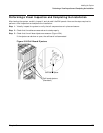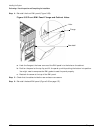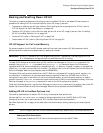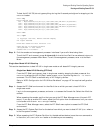
Chapter 4
Booting and Shutting Down the Operating System
System Boot Configuration Options
142
Manager utility) to manage boot options for your system disk. The OpenVMS I64 Boot Manager
(BOOT_OPTIONS.COM) utility is a menu-based utility and is easier to use than EFI. To configure OpenVMS
I64 booting on Fibre Channel devices, you must use the OpenVMS I64 Boot Manager utility
(BOOT_OPTIONS.COM). For more information on this utility and other restrictions, refer to the HP
OpenVMS for Integrity Servers Upgrade and Installation Manual.
For details, refer to the following sections.
— To set HP-UX boot options refer to “Adding HP-UX to the Boot Options List” on page 145.
— To set OpenVMS boot options refer to “Adding HP OpenVMS to the Boot Options List” on page 153.
— To set Windows boot options refer to “Adding Microsoft Windows to the Boot Options List” on
page 158.
— To set Linux boot options refer to “Adding Linux to the Boot Options List” on page 163.
• Hyper-Threading
nPartitions that have dual-core Intel® Itanium® 2 processors can support Hyper-Threading.
Hyper-Threading provides the ability for processors to create a second virtual core that allows additional
efficiencies of processing. For example, a dual-core processor with Hyper-Threading active can
simultaneously run four threads.
The EFI Shell cpuconfig command can enable and disable Hyper-Threading for an nPartition whose
processors support it. Recent releases of the nPartition Commands and Partition Manager also support
Hyper-Threading.
Details of the cpuconfig command are given below and are available by entering help cpuconfig at the
EFI Shell.
— cpuconfig threads — Reports Hyper-Threading status for the nPartition
— cpuconfig threads on — Enables Hyper-Threading for the nPartition. After enabling
Hyper-Threading the nPartition must be reset for Hyper-Threading to be active.
— cpuconfig threads off — Disables Hyper-Threading for the nPartition. After disabling
Hyper-Threading the nPartition must be reset for Hyper-Threading to be inactive
After enabling or disabling Hyper-Threading, the nPartition must be reset for the Hyper-Threading
change to take effect. Use the EFI Shell reset command.
Enabled means that Hyper-Threading will be active on the next reboot of the nPartition. Active means
that each processor core in the nPartition has a second virtual core that enables simultaneously running
multiple threads.
• Autoboot Setting
You can configure the autoboot setting for each nPartition either by using the autoboot command at the
EFI Shell, or by using the Set Auto Boot TimeOut menu item at the EFI Boot Option Maintenance menu.
To set autoboot from HP-UX, use the setboot command.
• ACPI Configuration Value—HP Integrity Server OS Boot
On cell-based HP Integrity servers you must set the proper ACPI configuration for the OS that will be
booted on the nPartition.
To check the ACPI configuration value, issue the acpiconfig command with no arguments at the EFI
Shell.


















